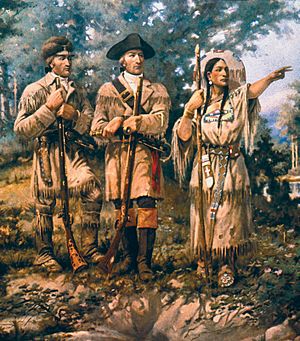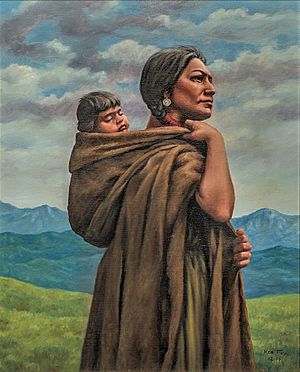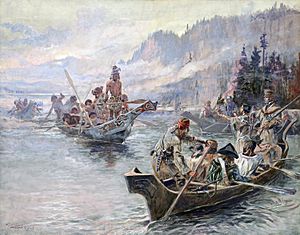Sacagawea facts for kids
Quick facts for kids
Sacagawea
|
|
|---|---|

Sacagawea (right) with Lewis and Clark at the Three Forks, mural at Montana House of Representatives
|
|
| Born | May 1788 Lemhi River Valley, near present-day Salmon, Idaho, US
|
| Died | December 20, 1812 (aged 24) or April 9, 1884 (aged 95) |
| Nationality | Lemhi Shoshone |
| Other names | Sakakawea, Sacajawea |
| Known for | Accompanied the Lewis and Clark Expedition |
| Spouse(s) | Toussaint Charbonneau |
| Children | 2, including Jean Baptiste Charbonneau |
Sacagawea (c. 1788 – c. December 20, 1812; was a Lemhi Shoshone woman, who went along with the Lewis and Clark Expedition as an interpreter and guide. Lewis and Clark explored the Western United States with her, traveling thousands of miles from North Dakota to the Pacific Ocean between 1804 and 1806.
Contents
Biography
Early life
There is little information that is definitively known about Sacagawea.
At about thirteen years of age, Sacagawea was taken as a wife by Toussaint Charbonneau, a Quebecer trapper living in the village. He had also taken another young Shoshone named Otter Woman as a wife.
The Lewis and Clark expedition
Sacagawea was pregnant with her first child when the Corps of Discovery arrived near the Hidatsa villages to spend the winter of 1804–1805. Captains Meriwether Lewis and William Clark built Fort Mandan. They interviewed several trappers who might be able to interpret or guide the expedition up the Missouri River in the springtime. They agreed to hire Charbonneau as an interpreter when they discovered his wife spoke Shoshone, as they knew they would need the help of Shoshone tribes at the headwaters of the Missouri.
Lewis wrote in his journal on November 4, 1804:
"a French man by Name Chabonah, who speaks the Big Belly language visit us, he wished to hire and informed us his 2 squars ("squaws") were Snake Indians, we engage him to go on with us and take one his wives to interpret the Snake language…"
Charbonneau and Sacagawea moved into the expedition's fort a week later. Clark nicknamed her Janey. Lewis wrote about the birth of Jean Baptiste Charbonneau on February 11, 1805.
In April, the expedition left Fort Mandan and headed up the Missouri River in pirogues. They had to be poled against the current and sometimes pulled from the riverbanks. On May 14, 1805, Sacagawea rescued items that had fallen out of a capsized boat, including the journals and records of Lewis and Clark. The corps commanders, who praised her quick action, named the Sacagawea River in her honor on May 20.
By August 1805, the corps had found a Shoshone tribe and was trying to trade for horses to cross the Rocky Mountains. They used Sacagawea to interpret and discovered that the tribe's chief was her brother Cameahwait.
Lewis recorded their reunion in his journal:
"Shortly after Capt. Clark arrived with the Interpreter Charbono, and the Indian woman, who proved to be a sister of the Chief Cameahwait. The meeting of those people was really affecting, particularly between Sah cah-gar-we-ah and an Indian woman, who had been taken prisoner at the same time with her, and who had afterwards escaped from the Minnetares and rejoined her nation."
And Clark in his:
"The Interpreter & Square who were before me at Some distance danced for the joyful Sight, and She made signs to me that they were her nation."
The Shoshone agreed to trade horses to the group, and to provide guides to lead them over the cold and barren Rocky Mountains. The trip was so hard that they were had to eat candles just to live. When they went down into the more temperate regions on the other side, Sacagawea helped to find and cook camas roots to help them get their strength back.
As the expedition approached the mouth of the Columbia River on the Pacific Coast, Sacagawea gave up her beaded belt to let the captains trade for a fur robe they wanted to give to President Thomas Jefferson.
On the trip back, they came near the Rocky Mountains in July 1806. On July 6, Clark wrote "The Indian woman informed me that she had been in this plain frequently and knew it well.... She said we would discover a gap in the mountains in our direction..." which is now Gibbons Pass. A week later, on July 13, Sacagawea told Clark to cross into the Yellowstone River basin at what is now known as Bozeman Pass. This was later chosen as the best route for the Northern Pacific Railway to cross the continental divide.
While Sacagawea has been thought of as a guide for the expedition, she probably only gave directions a few times. Her work as an interpreter certainly helped the party to talk with the Shoshone. However, the most important thing she did for the group may have been being there during the hard journey, which showed they did not want to attack any Native Americans they came across. While traveling through what is now Franklin County, Washington, Clark noted, "The Indian woman confirmed those people of our friendly intentions, as no woman ever accompanies a war party of Indians in this quarter," and, "the wife of Shabono our interpreter we find reconciles all the Indians, as to our friendly intentions a woman with a party of men is a token of peace."
Later life and death
After the expedition, Charbonneau and Sacagawea spent three years among the Hidatsa before accepting William Clark's invitation to live in St. Louis, Missouri in 1809.
Sacagawea gave birth to a daughter, Lizette, sometime after 1810. According to Bonnie "Spirit Wind-Walker" Butterfield, historical documents say that Sacagawea died in 1812 of an unknown sickness:
- "An 1811 journal entry made by Henry Brackenridge, a fur dealer at Fort Manuel Lisa Trading Post on the Missouri River, stated that both Sacagawea and Charbonneau were living at the fort. He recorded that Sacagawea "…had become sickly and longed to revisit her native country." The following year, John Luttig, a clerk at Fort Manuel Lisa recorded in his journal on December 20, 1812, that "…the wife of Charbonneau, a Snake Squaw [the common term used to denote Shoshone Indians], died of putrid fever." He went on to say that she was "aged about 25 years. She left a fine infant girl". Documents held by Clark show that her son Baptiste had already been entrusted by Charbonneau into Clark's care for a boarding school education, at Clark's insistence (Jackson, 1962)."
As further proof that Sacagawea died in 1812, Butterfield writes: "An adoption document made in the Orphans Court Records in St. Louis, Missouri states, 'On August 11, 1813, William Clark became the guardian of 'Tousant Charbonneau, a boy about ten years, and Lizette Charbonneau, a girl about one year old.' For a Missouri State Court at the time, to designate a child as orphaned and to allow an adoption, both parents had to be confirmed dead in court papers."
Name
Sacagawea is the most widely used spelling of her name. Lewis and Clark's original journals mention Sacagawea by name seventeen times, spelled eight different ways, all with a "g".
The spelling Sacagawea was established in 1910 by the Bureau of American Ethnology as the proper usage in government documents. It would be the spelling adopted by the U.S. Mint for use with the dollar coin, as well as the U.S. Board on Geographic Names and the National Park Service. The spelling is also used by numerous historical scholars.
The spelling Sacajawea is said to have derived from Shoshone Saca-tzaw-meah, meaning 'boat puller' or 'boat launcher'. In contrast to the Hidatsa etymology more popular among academics, Sacajawea is the preferred spelling used by her own tribe, the Lemhi Shoshone people, some of whom claim that her Hidatsa captors transliterated her Shoshone name in their own language and pronounced it according to their own dialect. That is, they heard a name that approximated tsakaka and wia, and interpreted it as 'bird woman', substituting their hard "g/k" pronunciation for the softer "tz/j" sound that did not exist in the Hidatsa language.
Memorials and honors

The Sacajawea Interpretive, Cultural, and Educational Center, located in Salmon, Idaho, by the rivers and mountains of Sacajawea's homeland. It contains a small museum and gift shop, in a 71-acre (290,000 m2) park. It is "owned and operated by the City of Salmon, in partnership with the Bureau of Land Management, Idaho Governor's Lewis & Clark Trail Committee, Salmon-Challis National Forest, Idaho Department of Fish & Game, and numerous non-profit and volunteer organizations."
Sacagawea was an important member of the Lewis and Clark Expedition. The National American Woman Suffrage Association of the early 20th century adopted her as a symbol of women's worth and independence, erecting several statues and plaques in her memory, and doing much to spread the story of her accomplishments.
In 1959, Sacagawea was inducted into the Hall of Great Westerners of the National Cowboy & Western Heritage Museum. In 1976, she was inducted into the National Cowgirl Museum and Hall of Fame in Fort Worth, Texas. In 2001, she was given the title of Honorary Sergeant, Regular Army, by President Bill Clinton. In 2003, she was inducted into the National Women's Hall of Fame.
The USS Sacagawea is one of several United States ships named in her honor.
Coinage
In 2000, the United States Mint issued the Sacagawea dollar coin in her honor, depicting Sacagawea and her son, Jean Baptiste Charbonneau. Because no contemporary image of Sacagawea exists, the face on the coin was modeled on a modern Shoshone-Bannock woman, Randy'L He-dow Teton. The portrait design is unusual, as the copyrights have been assigned to and are owned by the U.S. Mint. The portrait is not in the public domain, as most US coin designs are.
Geography and parks
- Lake Sakakawea in North Dakota
- Sacajawea Memorial Area, at Lemhi Pass, a National Historic Landmark managed by the National Forest Service and located on the boundary of Montana and Idaho, where visitors can hike the Lewis and Clark National Historic Trail. The Daughters of the American Revolution (DAR) created the memorial area in 1932 to honor Sacajawea for her role in the success of the Lewis and Clark Expedition.
- Mount Sacagawea, Fremont County, Wyoming, and the associated Sacagawea Glacier
- Sacagawea Heritage Trail, a bike trail in Tri-Cities, Washington
- Sacajawea Patera, a caldera on the planet Venus
- Sacajawea Peak
- Wallowa County, Oregon
- Sacagawea Park, Gallatin County, Montana
- Custer County, Idaho
- Sacagawea River in Montana
- Sacajawea State Park in Pasco, Washington
Images for kids
-
Sacajawea and Jean-Baptiste (1905), Washington Park (Portland, Oregon), Alice Cooper, sculptor
See also
 In Spanish: Sacajawea para niños
In Spanish: Sacajawea para niños





